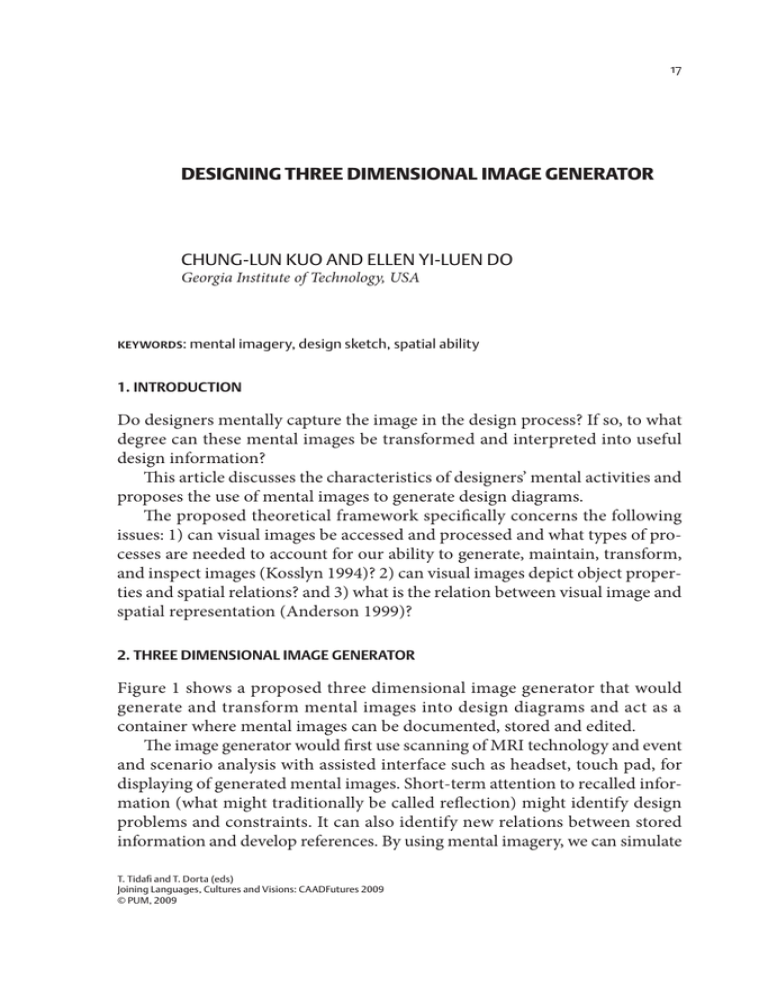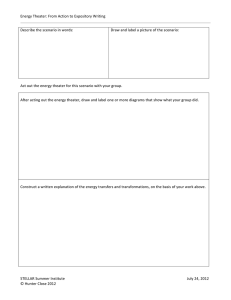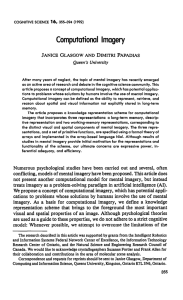DESIGNING THREE DIMENSIONAL IMAGE GENERATOR
advertisement

17 DESIGNING THREE DIMENSIONAL IMAGE GENERATOR CHUNG-LUN KUO AND ELLEN YI-LUEN DO Georgia Institute of Technology, USA keywords: mental imagery, design sketch, spatial ability 1. INTRODUCTION Do designers mentally capture the image in the design process? If so, to what degree can these mental images be transformed and interpreted into useful design information? This article discusses the characteristics of designers’ mental activities and proposes the use of mental images to generate design diagrams. The proposed theoretical framework specifically concerns the following issues: 1) can visual images be accessed and processed and what types of processes are needed to account for our ability to generate, maintain, transform, and inspect images (Kosslyn 1994)? 2) can visual images depict object properties and spatial relations? and 3) what is the relation between visual image and spatial representation (Anderson 1999)? 2. THREE DIMENSIONAL IMAGE GENERATOR Figure 1 shows a proposed three dimensional image generator that would generate and transform mental images into design diagrams and act as a container where mental images can be documented, stored and edited. The image generator would first use scanning of MRI technology and event and scenario analysis with assisted interface such as headset, touch pad, for displaying of generated mental images. Short-term attention to recalled information (what might traditionally be called reflection) might identify design problems and constraints. It can also identify new relations between stored information and develop references. By using mental imagery, we can simulate T. Tidafi and T. Dorta (eds) Joining Languages, Cultures and Visions: CAADFutures 2009 © pum, 2009 18 C.-L. KUO • E. Y.-L. DO experiences or design events such as walking through a space or viewing a scene (Do 2001). This suggests a scenario-based system, which involves cognitive processes from participants and helps to generate rich and powerful mental images in an efficient way. It can also recall previous data stored in the heads, identify the spatial relations between image objects and interpret them within a reference frame. figure 1. workflow of image-diagram processing Scenario (design event) analysis encompasses design phases and supports diverse behaviors of different user groups. It starts with collecting relevant events. For instance, one may imagine a house by using images and features from previous experience. Thus, the space design can begin from the portfolio of events. As an example, a story can be divided into a set of script writing and some “mental” pictures as a main body of the scenario. An event is composed of a set of description, a series of pictures or diagrams describing where or when peoples move or perform different behaviors. Similar events connect to a specific scenario and provide a basis for animation and simulation. An image object is a scenario element in this context. It could be tangible such as a chair, an entrance with texture, color and scale or intangible such as a movement of walking or opening door and so forth. REFERENCES Anderson, RE: 1999, Imagery and spatial representation, A Companion to Cognitive Science. G. G. William Bechtel. Oxford, Blackwell Publishers Ltd., pp. 204-211. Do, EY: 2001, VR Sketchpad: Creating Instant 3D Worlds by Sketching on a Transparent Window, CAAD Futures 2001, pp. 161-172. Kosslyn, S.M: 1994, Image and Brain: the resolution of imagery debate; Chapters 9, 10. Cambridge The MIT Press.



